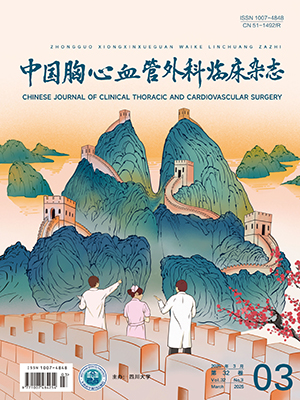| 1. |
孙立忠, 刘志刚, 常谦, 等. 主动脉弓替换加支架"象鼻"手术治疗Stanford A型主动脉夹层. 中华外科杂志, 2004, 42(13): 812-816.
|
| 2. |
Bavaria J, Milewski RK, Baker J, et al. Classic hybrid evolving approach to distal arch aneurysms: Toward the zone zero solution. J Thorac Cardiovasc Surg, 2010, 140(6 Suppl): S77-S80.
|
| 3. |
舒畅, 施俊哲, 葛建军, 等. 杂交技术治疗累及弓部主动脉病变的中国专家共识. 中国循环杂志, 2020, 35(2): 124-129.
|
| 4. |
Zhang L, Yu C, Yang X, et al. Hybrid and frozen elephant trunk for total arch replacement in DeBakey type Ⅰ dissection. J Thorac Cardiovasc Surg, 2019, 158(5): 1285-1292.
|
| 5. |
朱志成, 柳克祥, 王天策, 等. 改良“三明治”近端主动脉成形法在Stanford A型主动脉夹层中的应用. 中国循环杂志, 2013, 28(z1): 215.
|
| 6. |
陆清声. 主动脉弓疾病腔内治疗体外开窗技巧. 中国血管外科杂志(电子版), 2019, 11(2): 83-85.
|
| 7. |
Tan TW, Coulter AH, Zhang WW. Percutaneous in situ left subclavian artery fenestration using reentry catheter during endovascular thoracic aortic aneurysm repair. Int J Angiol, 2016, 25(5): e77-e80.
|
| 8. |
Mészáros I, Mórocz J, Szlávi J, et al. Epidemiology and clinicopathology of aortic dissection. Chest, 2000, 117(5): 1271-1278.
|
| 9. |
Hagan PG, Nienaber CA, Isselbacher EM, et al. The International Registry of Acute Aortic Dissection (IRAD): New insights into an old disease. JAMA, 2000, 283(7): 897-903.
|
| 10. |
Mizuno T, Toyama M, Tabuchi N, et al. Stented elephant trunk procedure combined with ascending aorta and arch replacement for acute type A aortic dissection. Eur J Cardiothorac Surg, 2002, 22(4): 504-509.
|
| 11. |
Etz CD, Weigang E, Hartert M, et al. Contemporary spinal cord protection during thoracic and thoracoabdominal aortic surgery and endovascular aortic repair: A position paper of the vascular domain of the European Association for Cardio-Thoracic Surgery. Eur J Cardiothorac Surg, 2015, 47(6): 943-957.
|
| 12. |
Kazimierczak A, Jedrzejczak T, Rynio P, et al. Favorable remodeling after hybrid arch debranching and modified provisional extension to induce complete attachment technique in type A aortic dissection: A case report. Medicine (Baltimore), 2018, 97(37): e12409.
|
| 13. |
Gaudino M, Bakaeen F, Davierwala P, et al. New strategies for surgical myocardial revascularization. Circulation, 2018, 138(19): 2160-2168.
|
| 14. |
Moulakakis KG, Mylonas SN, Markatis F, et al. A systematic review and meta-analysis of hybrid aortic arch replacement. Ann Cardiothorac Surg, 2013, 2(3): 247-260.
|
| 15. |
Aboyans V, Desormais I, Magne J, et al. Renal artery stenosis in patients with peripheral artery disease: Prevalence, risk factors and long-term prognosis. Eur J Vasc Endovasc Surg, 2017, 53(3): 380-385.
|
| 16. |
石烽, 王志维, 吴红兵, 等. 杂交手术治疗Stanford A型主动脉夹层. 实用医学杂志, 2019, 35(13): 2175-2179.
|
| 17. |
赵名贤, 张理, 李国杰. Castor分支型覆膜支架治疗锚定区不足的B型主动脉夹层的效果分析. 临床外科杂志, 2021, 29(9): 869-871.
|
| 18. |
Luebke T, Brunkwall J. Outcome of patients with open and endovascular repair in acute complicated type B aortic dissection: A systematic review and meta-analysis of case series and comparative studies. J Cardiovasc Surg (Torino), 2010, 51(5): 613-632.
|
| 19. |
Stone DH, Brewster DC, Kwolek CJ, et al. Stent-graft versus open-surgical repair of the thoracic aorta: mid-term results. J Vasc Surg, 2006, 44(6): 1188-1197.
|
| 20. |
成青鉴, 何瑜媛, 车辙, 等. 腔内治疗破口位于升主动脉的 Stanford A 型主动脉夹层. 中国普外基础与临床杂志, 2020, 27(6): 729-733.
|
| 21. |
Murphy EH, Stanley GA, Ilves M, et al. Thoracic endovascular repair (TEVAR) in the management of aortic arch pathology. Ann Vasc Surg, 2012, 26(1): 55-66.
|
| 22. |
陆清声. 分支支架技术在弓部分支血管重建中的应用及评价. 中国实用外科杂志, 2018, 38(12): 1369-1373.
|
| 23. |
舒畅, 王暾, 黎明, 等. “烟囱”技术在治疗累及主动脉弓分支动脉的Stanford B型主动脉夹层中的应用. 中华医学杂志, 2012, 92(47): 3320-3323.
|
| 24. |
舒畅, 王暾, 李全明, 等. 腔内修复联合辅助技术治疗累及主动脉弓的Stanford B型夹层动脉瘤. 中华普通外科杂志, 2011, 26(11): 899-903.
|
| 25. |
吴明乐, 陈旭, 汪华, 等. 转流技术在Standford B型主动脉夹层治疗中的应用及疗效评价. 世界中医药, 2015, 10(A02): 821-822.
|
| 26. |
陈燕青, 陆清声. 多层裸支架技术治疗动脉瘤的研究进展. 中华普通外科杂志, 2016, 31(8): 699-701.
|
| 27. |
李晓晔, 陆清声. 主动脉弓疾病腔内治疗分支重建进展. 中华血管外科杂志, 2021, 6(2): 77-80.
|
| 28. |
Malaisrie SC, Szeto WY, Halas M, et al. 2021 The American Association for Thoracic Surgery expert consensus document: Surgical treatment of acute type A aortic dissection. J Thorac Cardiovasc Surg, 2021, 162(3): 735-758.
|




